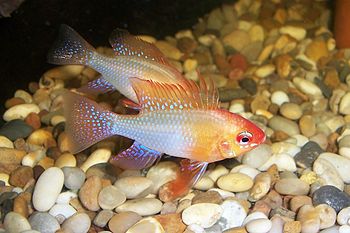 |
| Ram cichlid, Mikrogeophagus ramirezi (Photo credit: Wikipedia) |
Doesn't matter what they call it, at least scientifically, I like these fish. They have a very gentle personality and are extremely passive, keeping pretty much to themselves when they are added to a community aquarium. In fact, this is often a problem, they are so easily intimidated by more active swimming fish that they may never become as colourful as they can be. Even if other fish are not even trying to bother them, swift movements and rapid fish can simply be too much and the fish will waste away. For this reason, I most often will simply give the group a tank of their own and let the interactions in their own community offer the action in the tank. In a species tank like this, I often see much more interaction between the individuals. It may only be my opinion, but the social characteristics of these fish as a group is well worth devoting a small tank just to them.
In my experience they can be quite delicate and prefer softer acid water, some of the books do note they will tolerate up to neutral (7.0 pH) water, but I feel that is a maximum limit, lower pH down to 6.5 are much more preferable. Above all, they simply do not tolerate environmental changes well. Be very careful when adding any type of chemical, if you must treat the water for softness and acidity, try to do it naturally, possibly with peat rather than chemical treatments that can cause the conditions to rapidly fluctuate. It is much better to allow the change to be very gradual, rather than all of a sudden. and always ensure the water you are replacing during regular aquarium maintenance protocols has been properly treated outside the aquarium to eliminate chlorine and other toxins well before coming in contact with the aquarium.
If you give do give them the conditions they require and let them settle in and get comfortable, you will watch one of the true jewels of the freshwater tropical fish species as it goes about its business. Too much action by other species in the tank and it the entire group will become timid and easily spooked, but in the right conditions, it is truly a spectacular addition to the small community aquarium. I have found the blue and gold rams can be mixed pretty easily and that they prefer to be in groups rather than simple pairs. The interaction of the group is quite social, so having at least five or six in the tank gives them chance to interact with interesting results.
Most of the tanks that I have kept Rams of assorted types have been pretty bare of plants, but with lots of rocks and ornaments that allow them to hide and claim as territory. They have survived and flourished in a rocky environment, and even bred repeatedly on a flat rock or on a grave impression they have dug. One of their many names was Microgeophagus - or little dirt eater. My observations show this is a good description for them. They will dig and move the gravel and can create hollows in the bottom, some have even spawned there. I would suggest using relatively small fine gravel for the bottom of a ram tank since they will be moving it around anyway, and large gravel will make the effort great.
I was not a fan of keeping live plants when I kept and bred these originally. The fact that they move the gravel means that any plants you keep for them must be well anchored. They do enjoy a planted tank with densely bunched plants that offer places to hide and disappear within, but like my previous environments, they do need plenty of open bottom swimming area as well. In essence, the plants provide the same type of protection that a properly rocked aquarium will for them. Either way, when planting or rocking the aquarium, concentrate near the back and ensure there is a plenty of swimming space is probably the best way to set the aquarium. Other fish can be included in the habitat, but keep them to lazy swimming fish in the upper regions so there is little interaction between the rams and the other species.
The Gold Ram was the first Cichlid I tried my hand at keeping and breeding. When I first saw them introduced a few decades ago to my area, I knew I wanted to see what they were about. Once I looked into them, the general Cichlid species characteristics intrigued me, having had my fill of fish that evidence no parental behaviour, either giving birth and abandoning them as they drop or simply scattering eggs and ignoring them afterwards. it was a refreshing change of pace to finally encounter fish that actually cared for their eggs until they hatch, protecting the clutch and the area from unwanted intruders. This is the time when rams become their most aggressive.
Sure there are a lot of other Dwarf Cichlids, and many of them are just as stunning, but I have yet to see any fish with the depth and brilliance of colour as a well-conditioned Blue Ram in full breeding colours showing off for a receptive female. These dwarfs do not have as pronounced roles for the parental care as many of their larger cousins display. The roles blur and both do what is required without as clear-cut responsibilities. They can be a problem to keep happy, but when they do breed and the eggs have been laid, it is best to remove other occupants and let the eggs hatch. Once the babies are fully free swimming, they can be removed to a grow out tank.
|




